Blue Fescue (Festuca glauca), also known as Common Blue Fescue or Elijah Blue, is a compact, clump-forming evergreen perennial. Belonging to the Poaceae family, this ornamental grass is native to regions spanning from Northeast Spain to Northwest Italy and Southern France. Its Latin name, Festuca glauca, translates to “pale blue-grey,” reflecting its striking foliage color.
Thriving in USDA hardiness zones 4 through 9, Blue Fescue is a popular choice for ornamental groundcover. It is prized for its neat, mounded appearance and silvery-blue blades that add texture and contrast to gardens. However, its vigorous growth can sometimes lead it to spread unintentionally, requiring regular maintenance to prevent it from becoming invasive.
Ideal for rock gardens, borders, and container plantings, Blue Fescue is a low-maintenance option that combines aesthetic appeal with adaptability, making it a favorite among gardening enthusiasts.
| Common name | Blue Fescue, Common Blue Fescue, Elijah Blue |
| Botanical name | Festuca glauca |
| Family | Poaceae |
| Species | glauca |
| Origin | North East Spain to North West Italy and Southern France |
| Plant type | Ornamental Grasses and Sedges |
| Hardiness zone | 4, 5, 6, 7, 8, 9 |
| Sunlight | Dappled Sunlight |
| Maintenance | Low |
| Drainage | Well-Drained |
| Spacing | 12 in. – 3 ft. |
| Flowering period | Spring |
| Height | 6 in. – 1 ft. |
| Flower color | Blue |
| Leaf color | Blue |
| Fruit type | Caryopsis |
| Leaf benefit | Long-lasting |
| Garden style | Butterfly Garden |
| Uses | Container |
I. Appearance and Characteristics
Festuca glauca, commonly known as blue fescue, is a species of flowering plant in the grass family, Poaceae. It is a commonly cultivated evergreen or semi-evergreen herbaceous perennial. Blue fescue is native to France, Italy, Spain, and Switzerland.
Common names include blue fescue, blue mountain grass, and grey fescue. It was originally described by French naturalist Dominique Villars.
The genus name Festuca means ‘straw’, and is a name that was used by Pliny the Elder. ‘Festuca’ also refers to a rod used to manumit Romans from slavery to freedom.
The species name glauca is derived from Latin and means ‘with a white or greyish bloom’, or ‘glaucous’. It is a cognate of the word ‘glaucoma’.
F. glauca is a perennial clump-forming ornamental grass noted for its glaucous, finely-textured, blue-gray foliage. The foliage forms a dome-shaped, porcupine-like tuft of erect to arching, needle-like 9-ribbed blades, radiating upward and outward to a length of 140–180 mm. Light green flowers with a purple tinge appear in terminal panicles atop stems rising above the foliage in late spring to early summer, but inflorescences are not very showy. Flowers give way to puffy wheat-like seed-heads.
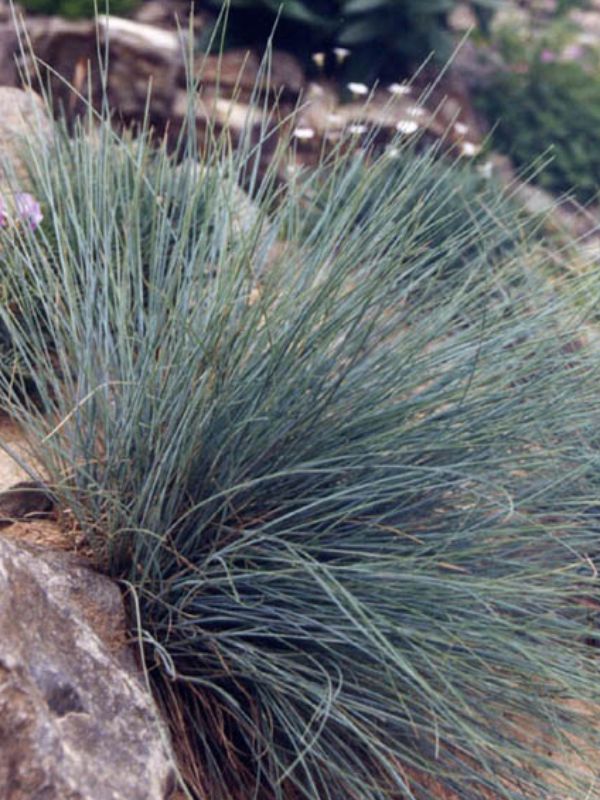
In cultivation F. glauca can reach a height of 14–18 cm (6–7 in) (inflorescences typically bring total clump height to 20–25 cm (8–10 in)). It does best in well-drained soil as plants will not grow well in wet soils. It tolerates dry and low nutrient soils. Plant in a full sun for best foliage colour. It will also grow in a lightly shaded position. Will tolerate drought, neglect and lack of nutrients but prefers regular watering. If plant has a large amount of dead leaves, prune back to 40mm from ground level. This is to be done in winter. Lift and divide clumps if needed (also to be done in winter). Division of established clumps in winter is the easiest method although plants can also be grown from seed.
Plants require frequent division as clumps tend to die out in the center and need to be divided, replanted or replaced every 2–3 years. Plant foliage may decline considerably in very hot, humid summers. Weeds often build up amongst the clumps when used as groundcover and need to be removed by hand.
II. How to Grow and Care
Sunlight
Planting blue fescue in full sun will help the plant achieve its distinctive bright blue color. In partial sun, leaves tend to be more on the green side.
Temperature and Humidity
It’s important to remember that blue fescue is a cool-season grass; in warmer climates, there’s a chance that plants will die back and go dormant through the heat of the summer. If they do, you can cut the foliage back and wait. Blue fescue does most of its growing in the spring and fall, so once the weather starts to cool off again, the plant will develop bright, new growth. You can put the plants in part sun in warmer climates to keep them cooler and prevent summer dormancy.
Watering
This plant has average moisture needs. Water weekly during hot summer months to keep it green and growing; short periods of drought will stunt, but not kill the plant.
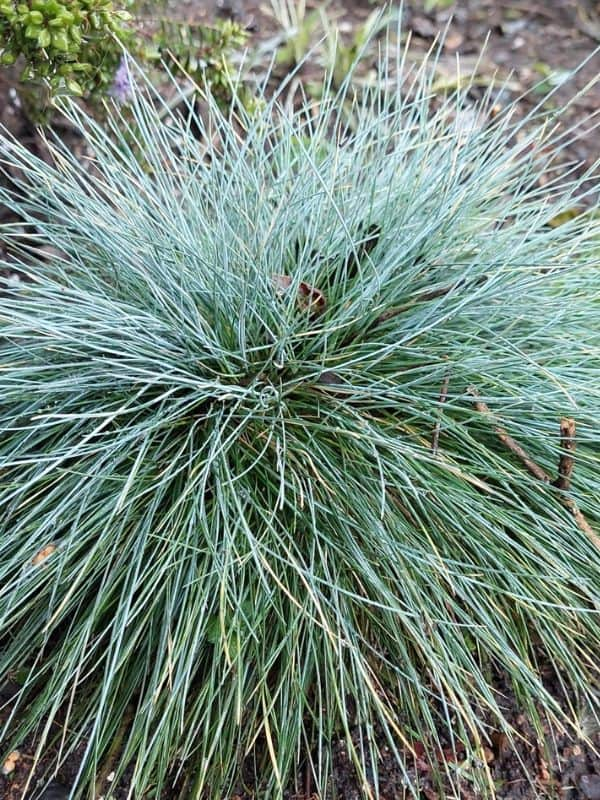
Soil
This plant prefers relatively consistently moist soil that is well-draining. It does not tolerate wet, soggy conditions. However, mature plants can withstand drought conditions.
Fertilizing
When blue fescue plants are surrounded by an organic mulch, such as compost or bark mulch, no additional fertilizer is needed.
Planting Instructions
Blue fescue is a small ornamental grass that grows as a perennial in Zones 4-8, where it brings vibrant blue color to garden beds and borders. It doesn’t go dormant, so it is suitable anywhere the home gardener wants winter color in all but the most frigid areas. It is drought-tolerant, making it a good choice for home gardeners who live in arid regions.
Plant blue fescue seeds in early spring or late summer but well before freezing temperatures arrive. Loosen the soil and add seed-starting mix. Sprinkle the seeds sparingly on top of the soil mixture and cover only lightly. After they germinate, thin the seedlings to 12 inches apart.
To plant blue fescue plants from a nursery, dig a hole that is as wide as the root ball of the plant. Locate it in a sunny spot with well-draining soil and add a granular slow-release balanced fertilizer before settling the plant in the hole at the same level it was in the container. Keep the soil moist, not wet.
Pruning
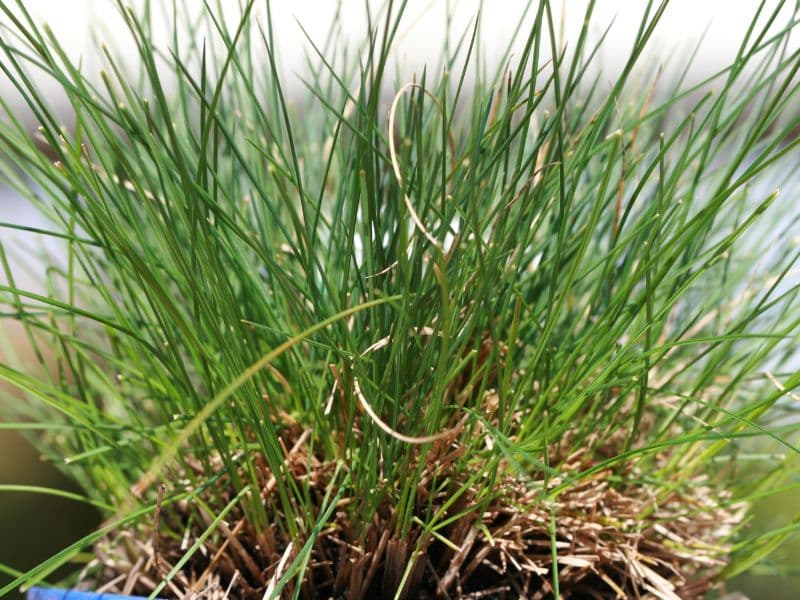
Cut back the foliage in early spring to within a few inches of the ground. This will help make room for the new grass blades and will improve the look of the plant.
To keep the foliage looking good, remove dead blades of grass. The flowers add movement to the garden, and the seed heads provide winter interest. Leaving the seed heads may cause the plant to self-seed; this can be fine if it’s located where you want it to spread but will require culling if you want to keep it confined.
Propagation
One of the best ways to propagate blue fescue is through division. (Blue fescue rarely lives past three to five years unless it is divided, so this is a must-do.) Here’s how:
- Pry the plant up out of the ground with a shovel or a garden trowel.
- Cut the clump in half using a spade or pruners. Remove any brown sections. While tempting, do not pull apart the clump with your hands as this may damage the root structure.
- Replant the clump sections as new plants, spacing them 8 to 10 inches apart.
- Cover the roots with soil. Water deeply right after planting and continue to water regularly until you see new growth.
How to Grow From Seed
It’s easy to grow blue fescue from seed. Start seeds indoors in late winter, in peat pots filled with seed-starting mix. Three seeds per pot are all you need, lightly covering with the selected soil and keeping them moist till they’re ready to go outside. Make sure to harden off seedlings before planting in the garden. Blue fescue seeds can also be sown outdoors, directly into the soil, either once the chance of frost has passed or in late summer.
Overwintering
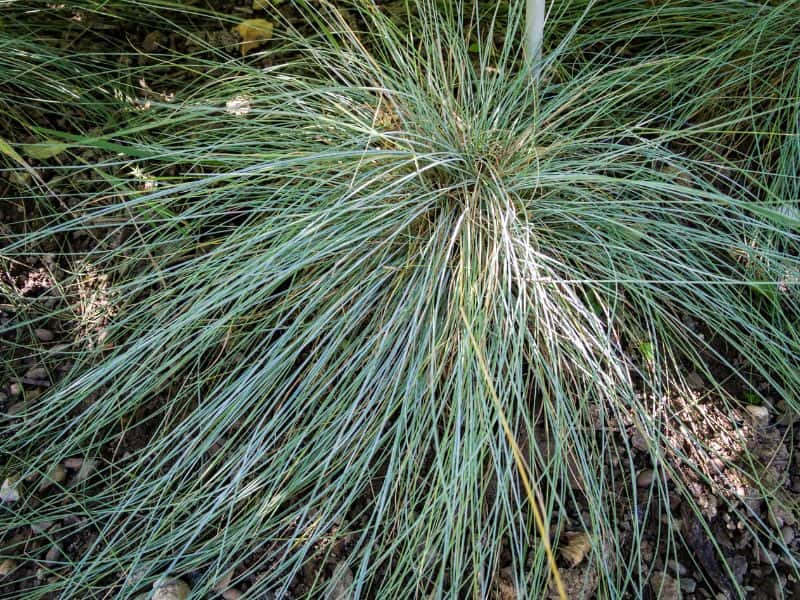
Fescue is a cool-season grass that is hardy to USDA zone 4. No special steps are required for overwintering. In cold climates, the grass turns brown in the winter, which is part of the natural dormancy process.
Repotting
Repot blue fescue every 2-3 years in spring, maximizing its compact, ornamental grass form. Choose containers a size larger for healthy root growth but maintain a snug fit. Post-repotting, place blue fescue in full sun with well-drained soil, water sparingly, and avoid over-fertilization to admire its blue-toned foliage without stress-induced browning.
Pests and Diseases
Common Pests
Aphids can be a problem with blue fescue. A blast of water can wash them away, but tougher infestations can be remedied with horticultural oil or insecticidal soaps.
Common Problems
Gardeners in warm climates may experience a different problem with blue fescue: above-ground growth may die back during the summer, due to excessive heat and humidity. When this happens, give the plant a “haircut,” since its appearance is temporarily spoiled anyway. In many cases, the plant will recover when more moderate weather returns.
III. Uses and Benefits

Blue fescue is a drought-proof ornamental grass with needle-like silver-blue rigid foliage that can add a great color accent to gravel and rock gardens, providing contrast with other plantings. Growing in compact mounds, it makes a good ground cover, looks great in beds and edging, and is suitable as a container plant.
IV. Types of Blue Fescue
- ‘Elijah Blue’ has light blue foliage and is the most popular cultivar.
- ‘Golden Toupee’ features chartreuse leaves.
- ‘Boulder Blue’ boasts a silver-blue hue and tolerates higher heat and humidity.
- ‘Blaufink’ offers compact features and a fine texture.
- ‘Tom Thumb’ grows to be only about 4 inches tall.
- ‘Harz’ displays an olive-green color, with a hint of purple at times.
Find Where to Buy the Best Blue Fescue (Festuca glauca)



.png)



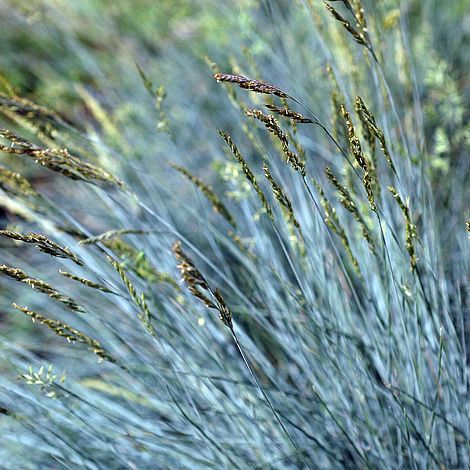

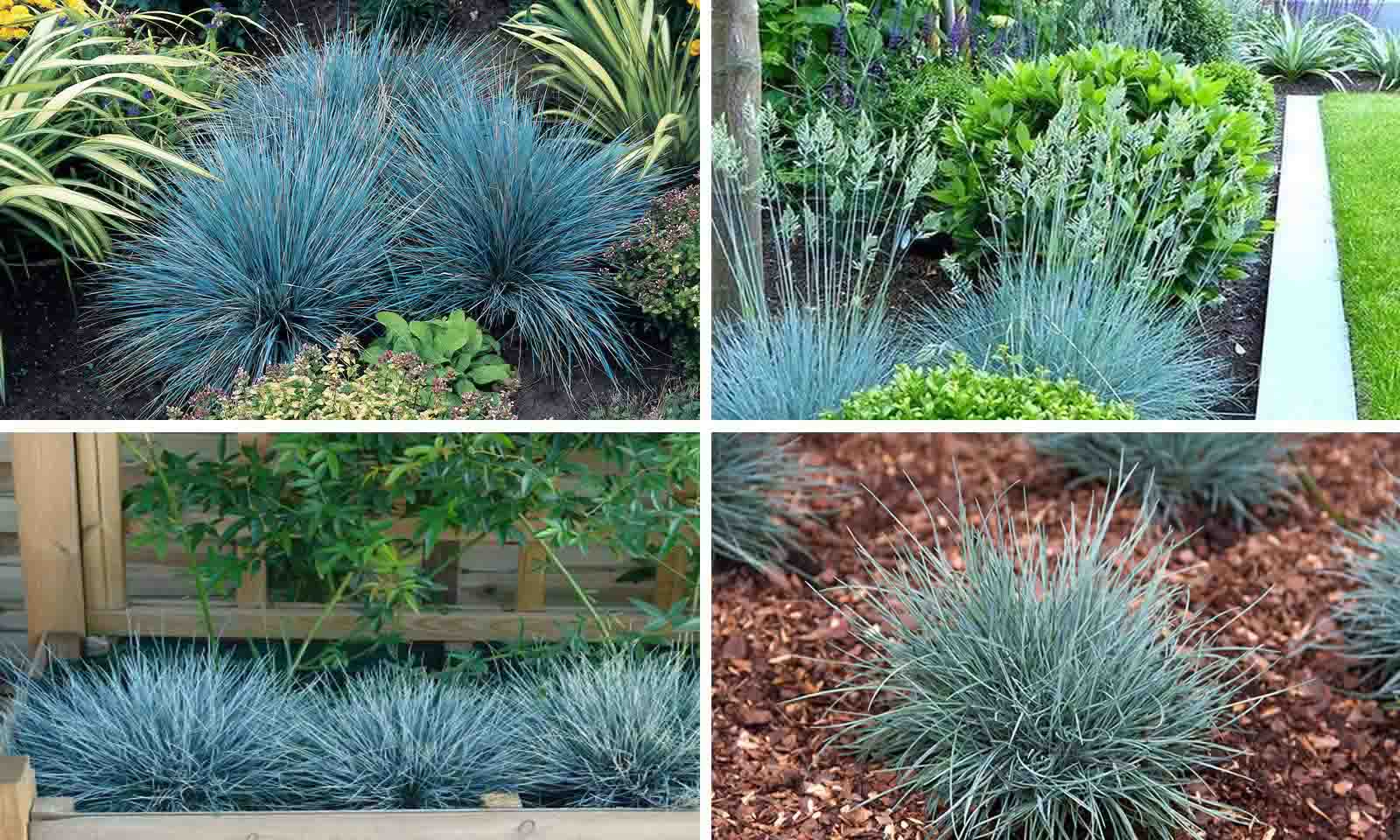








Leave a Reply